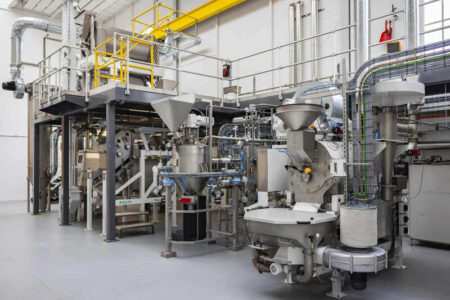Robot palletising system
Barry Callebaut, manufacturer of cocoa and chocolate products, has installed a robotic palletising system at its Banbury plant as part of a three-phase investment in the palletising area. CKF Systems of Gloucester was commissioned to design, build and install the system.
“We were impressed by work CKF had recently undertaken for a major confectionery brand,” explains Barnz Parkin, project management engineer, Barry Callebaut. “We spoke to the project manager, who has a wealth of experience and we regard highly and he provided a sound endorsement; a good partner, talented, flexible and reliable.”
“We looked at nine different organisations, but only CKF demonstrated a complete understanding of our situation and submitted a working solution that would improve our capabilities in line with budget and expectations. It was a major undertaking for the business and therefore essential that we made the right decision.”
The initial project is designed around a single robot cell but with the ability to palletise three different SKU’s at the same time. The cell, incorporating an ABB IRB 660 with a bespoke gripper, has been designed by CKF. It uses 3D Inventor and Robot Studio simulation to ensure the full range of case sizes, weights and configurations can be handled and are able to pick layer sheets. The case feed system comprises a high level interface complete with divert station and bar code detection, to direct the flow of designated cases to the robot cell and separate in to three defined collation stations. Each station incorporates an identical conditioning section to orientate and collate the cases into defined rows and counts for the robot pick to create the pallet pattern. A dedicated pallet load station is positioned at the end of each collation station and the cell also includes two separate layer sheet feed sections to handle both Chep and Euro pallet sized sheets.
The overall system includes two dedicated pallet denesters, i.e. Chep and Euro, loaded pallet discharge station and twin shuttle car. The shuttle car arrangement is designed to receive individual pallets, on demand, from the designated denester and deliver to the relevant pallet load station at start of production. The shuttle is also designed to receive and exchange both loaded and empty pallets, with the loaded pallets delivered to the unload station before the car returns to the denester stations to collect the next pallet. The final configuration of the system includes provision for the introduction of a second robot cell and a fully automatic spiral wrapping machine.
The complete operation is fully contained within a guard enclosure incorporating strategically positioned light beams, roller shutter door and interlocks to meet the very highest safety standards with zoned safety areas to maximise overall system efficiency.



